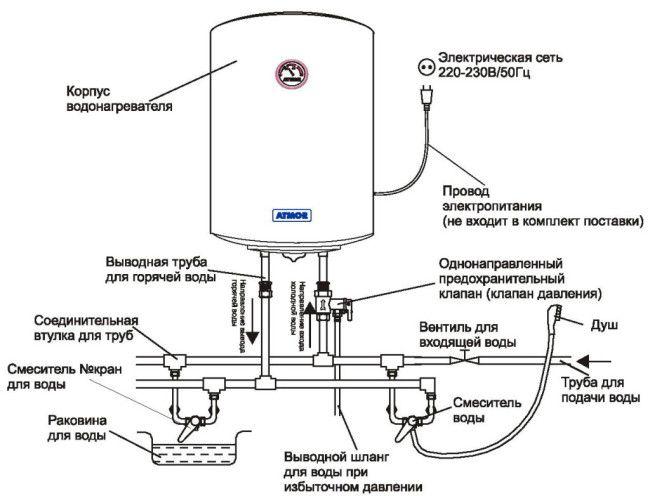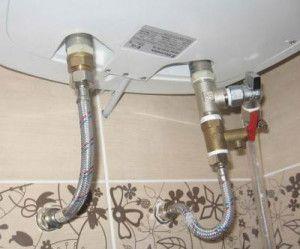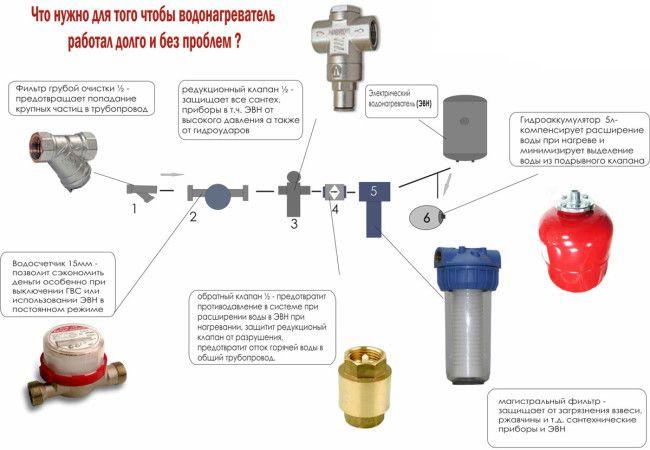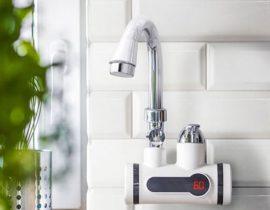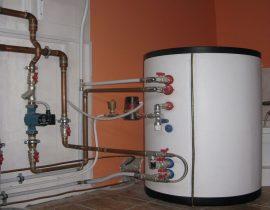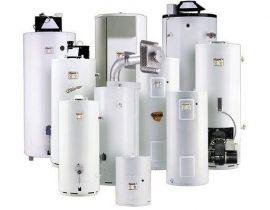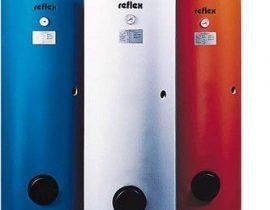Modern man has long been accustomed to good living conditions. One of the mandatory features of a "comfortable home" is a continuous supply of hot water. However, the main water supply has not yet reached every house. Moreover, even in homes with mains hot water, there are frequent cases when the flow of hot water dries up due to an accident or repair. As a rule, this happens at the most inopportune moment. To ensure the availability of hot water in the tap, boilers are widely used - heating devices. They can be gas and electric, storage or flow. But both are easy-to-use devices with a high degree of automation. Installing a boiler with your own hands, in principle, is not particularly difficult even for an unprepared user.
Content
The main types of water heating boilers
The main types of water heating boilers, regardless of the source of heating, are the following modifications:
- Accumulative - such devices have a fairly voluminous water tank in which heating takes place.After spending a certain amount of heated liquid, the tank is replenished with running cold water, after which it is heated again to the required temperature. Such devices may have a different volume of a tank for heated water and heating equipment of different power.
- Flow - heat water directly in the cold water pipe. Hot water immediately flows to the taps. Due to the fact that in a short time it is necessary to heat a powerful stream of water, such devices are equipped with powerful heating elements.
Calculation of the required boiler power
Electric water heating boilers have heating elements of different power. Therefore, at the initial stage of installing the boiler, it is necessary to find out the power of the purchased device and check the compliance of the electrical wiring in your room.
Wiring laid in residential premises has different maximum tolerances for the passing current strength. It may happen that at the installation site of the electric boiler there simply will not be wiring suitable for power. Such situations are not uncommon in houses of old construction. Moreover, in such houses, insufficient power can fit both the switchgear in the apartment and the electricity meter.
If necessary, you will need to install a separate circuit breaker on your apartment's switchboard and possibly run a new cable to the location of the electric water heater.
The process of self-installation of an electric boiler
A flowing electric water heater crashes into a cold water supply system. Thus, it is reasonable to install it directly in the place where the water pipe passes.As a rule, such instantaneous water heaters have a very simple installation: they are simply hung on the wall and connected to the plumbing system with flexible metallized hoses. Also, the boiler is connected to the electrical network. Usually modern electric water heaters have a so-called "European" plug, so make sure that there is an appropriate outlet in close proximity to the instantaneous boiler.
An important point is the calculation of the required cross-section of the electrical wiring that supplies power to the water heater. In the event that the wires have an insufficient diameter or are made of a not very good conductor (which is extremely common in old houses), sparking and even ignition of the wire junctions, or a short circuit, are possible.
How to calculate the cross section of the wiring to the electric water heater
To calculate the required cross-section of the wire that supplies power to the electric boiler, you need to remember that 1 square millimeter of copper wire can withstand a current of 10 amperes without damage. The current strength is calculated according to the simplest formula: the power of the electric heating element in the boiler is divided by the voltage in the Russian electrical household network (220 volts).
Thus, when installing an electric water heater with a power of 8 kilowatts, it is necessary to divide 8000 by 220. The desired figure will be 36, therefore, the cross section of copper wiring supplying power to such a heater must be at least 3.6 square millimeters. The cross section of the wire is indicated in its marking and is usually a multiple of the number "1". Thus, we need a copper wire, each core of which will have a cross section of at least 4 square millimeters.
After planning and installing the power supply, you can proceed directly to the installation of the boiler.
Ways to install instantaneous water heaters
There are temporary and permanent ways to connect flow-through electric boilers.
With a temporary installation option, a tee tap is attached to the water supply pipe and through a flexible metallized hose it is connected to the inlet pipe of the instantaneous water heater.
It must be remembered that in order for the instantaneous water heater not to fail, there must be water in it when the heating is turned on. Thus, turning the flow boiler on and off should look like this:
- The water supply to the instantaneous water heater is turned on,
- Electric heating is switched on
- Turn off the electric heating
- The water entering the heater is turned off.
Modern boilers may have automatic protection that prevents heating elements from turning on when there is no water in the system, but such models are a little more expensive.
With a stationary tie-in instantaneous water heater, it is installed parallel to the existing water supply system. To do this, a tee tap cuts into the cold water supply pipe. Thus, the flow of cold water is divided into two parts. One part of the water will go directly to the cold inlet of the mixer, and the second part will go to the inlet of the water heater, which is marked in blue. The heated water will flow into the hot inlet of the mixer.
Before starting the water heater in operating mode, it is necessary to check its tightness. If there are no leaks, plug it into the mains.
Connecting a storage electric boiler
The power of the heating element in a storage hot water boiler usually does not exceed 5 kilowatts.Thus, a copper cable with a cross section of one and a half square millimeters is quite enough to connect it. In such devices, a thermostat is often installed, which “monitors” the presence of hot water in the tank and can, if necessary, maintain the temperature in it at the desired, predetermined level. Installing and connecting a storage electric boiler is also not difficult, you can do without the services of a master and do everything yourself.
Please note that the storage boiler, and even filled with water, will have a decent total weight. Thus, the installation of such devices on light plasterboard walls is excluded - they will simply collapse under its weight.
After purchasing the storage boiler, you need to unpack it and find the mounting points. In accordance with their location, it is necessary to mark the place of fastening on the wall. To do this, use a tape measure, pencil and building level. When marking holes, take into account the way water is supplied to your boiler, leave the necessary space for placing taps, hoses and pipes.
It is better to make holes for plugs when installing a boiler with a perforator. We insert dowels into the holes, check the reliability of their fastening. Choose anchors that can support the total weight of the boiler (usually 35 to 90 kg) and the weight of the water in the tank.
In addition, to install the boiler, you need to stock up on additional equipment - ball valves, spurs (which align the diameters of the pipes when they are connected).
The easiest way to connect the water supply to the electric boiler is through the shut-off valves and then through the flexible piping.The cold water inlet is marked on the boiler with a blue mark. In addition, it is imperative to install a valve on the inlet pipe that will relieve excess pressure in the system (usually such valves are included). As an option, a tee-faucet with an attached drain cock can also be installed in front of the shut-off valves. This will allow you to quickly drain the water from the boiler during maintenance. All places of threaded connections are sealed with fum-tape or tow.
A flexible hose is attached to the outlet pipe, which will direct hot water to the corresponding line.
After connecting all the threaded connections, open the water and check the system for leaks, then connect the device to the power supply and begin operation.
It is better to connect the storage boiler to a separate electrical outlet. When connecting, we make sure that the total current strength on one outlet does not exceed the capabilities of your electrical wiring. It is better if the electric boiler is connected to the power supply in accordance with all the rules - in compliance with grounding.
After applying voltage to the electric boiler, the operation indicator should light up. Read the instructions and change the operating temperature as you wish.
Do-it-yourself boiler installation: instructional video
Safety regulations
Immediately after installing the boiler, it is recommended to install wet group RCD wiring. This is a special device that can save your life in the event of a breakdown of electric current through the heater to the water and through the water to you or your family members.
Attention! Boiler included may not go cord with plug, this is a normal situation! Such devices are powered directly to the network.This is indirectly done so that an electrician is involved in connecting your boiler, who will simultaneously evaluate the bandwidth of your wiring and conclude whether it is intended for such loads at all!



